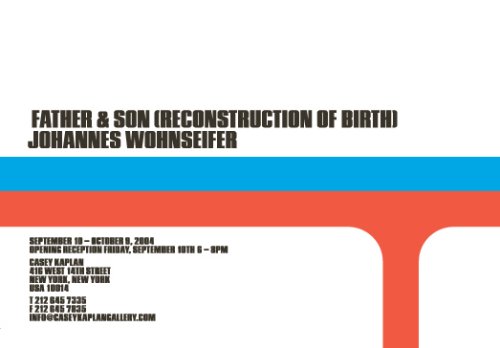Johannes Wohnseifer
dal 9/9/2004 al 9/10/2004
Segnalato da
9/9/2004
Johannes Wohnseifer
Casey Kaplan Gallery, New York
Father and Son (Reconstruction of Birth). The starting point for this exhibition takes its inspiration from a father and a son, Paul Schneider-Esleben and Florian Schneider-Esleben. As modernists, respectively in their fields of architecture and music, they actively initiated international exchange and dialogue from Germany in the 1960's and 1970's.

"FATHER AND SON (RECONSTRUCTION OF BIRTH)"
Casey Kaplan is pleased to present the first solo exhibition in New York of
Johannes Wohnseifer entitled, "Father and Son (Reconstruction of Birth)."
The Cologne-based artist interweaves a broad range of historical, political
and autobiographical references in an installation of signs and images that
exceed identifiable association.
The starting point for this exhibition takes its inspiration from a father
and a son, Paul Schneider-Esleben and Florian Schneider-Esleben. As
modernists, respectively in their fields of architecture and music, they
actively initiated international exchange and dialogue from Germany in the
1960's and 1970's.
In 1966, Paul Schneider-Esleben designed the terminal of the Cologne-Bonn
International Airport. With its modern architecture, contemporary furniture,
and new technical advancements, the airport served as a major gateway for
international travelers informing their initial experience to post-war
Germany. As a child, Wohnseifer¹s father often brought him to visit the
airport.
In 1970, Kraftwerk, with Florian Schneider-Esleben as one of its founding
members released its first self-titled LP 'Kraftwerk.' The band's futuristic
themes and funky rhythms had an enormous impact in the future development of
house, techno, hip-hop and other areas of modern music. The music of
Kraftwerk established an indisputable base for music scenes that would grow
and thrive globally, specifically in New York and Detroit. Furthermore,
Kraftwerk¹s first LP featured a double cover where on the inside there was a
black and white photograph of a transformer taken by Bernd and Hilla Becher.
The single image is highly unusual for the Bechers best known for their
serial work.
For Wohnseifer, these specific post-war German influences take form, and are
amplified in his artworks as sculptures, paintings and collages.
Wohnseifer further addresses his own personal history by relating the
Italian Grand Prix in Monza held on the date of the his birth, September
10th 1967. This race is particularly special because the winning racecar was
a hybrid of Honda's 12-cylinder motor. For this exhibition, the artist
traveled to the Honda Collection Hall in Motegi, Japan where he filmed and
recorded the original Honda RA 300 Formula One racecar that won the race.
Johannes Wohnseifer¹s interest in cultural and personal history results in
original conceptual experiences. Together, the presented artworks highlight
the malleable nature of visual perception where ideas and symbols quickly
shift meaning and new relationships are formed.
The artist¹s recent one-person exhibitions include: Sprengel Museum,
Hannover; Museum Ludwig, Cologne; Galerie Gisela Capitain, Cologne and
Johann König, Berlin, Germany. Group shows include: Neuer Aachener
Kunstverein, Aachen; Frankfurter Kunstverein, Frankfurt, Germany; and the
Yokohama Triennale, Japan in 2001. Johannes Wohnseifer is also featured in
Taschen¹s 2002 publication Art Now: 137 Artists at the Rise of the New
Millennium.
OPENING: FRIDAY, SEPTEMBER 10TH, 6 Â 8 PM
GALLERY HOURS: TUESDAY Â SATURDAY, 10 Â 6 PM
FOR FURTHER EXHIBITION INFORMATION PLEASE CONTACT THE GALLERY AT:
TEL. 212 645 7335 FAX. 212 645 7835
NEXT EXHIBITION: TRISHA DONNELLY: OCTOBER 15 Â NOVEMBER 2004, Opening
Reception, October 22nd, 6-8pm
AMY ADLER, JEFF BURTON, NATHAN CARTER, MILES COOLIDGE, JASON DODGE, TRISHA
DONNELLY, CEAL FLOYER, PAMELA FRASER, ANNA GASKELL, LIAM GILLICK, ANNIKA VON
HAUSSWOLFF, CARSTEN HÖLLER, JONATHAN MONK, DIEGO PERRONE, SIMON STARLING,
ANNIKA STRÖM, JOHANNES WOHNSEIFER
Casey Kaplan
416 West 14th Street
New York, NY 10014



